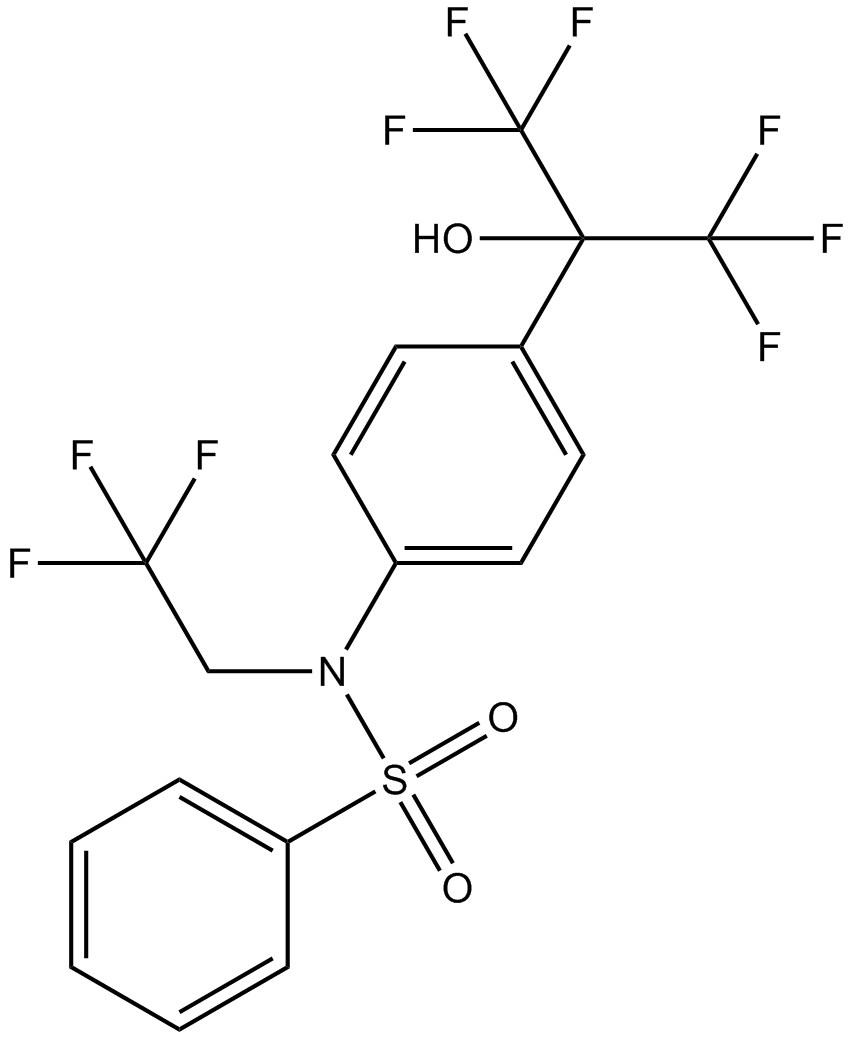T0901317 |
| カタログ番号GC10596 |
T0901317 は、LXRα の EC50 が 20 nM である、経口活性で選択性の高い LXR アゴニストです 。
Products are for research use only. Not for human use. We do not sell to patients.

Cas No.: 293754-55-9
Sample solution is provided at 25 µL, 10mM.
T0901317 is an agonist for multiple targets, which possesses EC50 values of 20 nM and 5 μM for LXRα and FXR, respectively. Furthermore, it is RORα and RORγ dual inverse agonist with estimated IC50 of 2.0 μM and 1.7 μM, respectively. [1, 2]
LXRs play central roles in cholesterol metabolism, which are nuclear receptors that regulate the metabolism of several important lipids, including cholesterol and bile acids. LXRs were first identified as orphan members of the nuclear receptor superfamily. Like LXRs, FXR was also initially thought as an orphan member of the nuclear receptor superfamily. But FXR was later identified as the physiological receptor for bile acids and shown to regulate a feedback loop for bile acid transport and synthesis as well as modulating additional functions in lipid metabolism. Retinoic acid receptor-related orphan receptors (RORs) are important in a variety of physiological processes including hepatic gluconeogenesis, lipid metabolism, circadian rhythm, and immunological functions. T0901317 inhibited transactivation activity of RORα and RORγ by direct binding with high affinity which led to the regulation of the receptor’s ability to interact with transcriptional cofactor proteins, but did not show inhibitory activity against RORβ. [1, 2]
A short synthetic rhodamine-labeled peptide was used to conduct a fluorescence polarization assay for T0901317 binding to LXRα. In this homogeneous biochemical assay, the greater the extent of rhodamine-peptide binding to LXR, the greater the extent of fluorescence polarization observed. The potency of T0901317 binding to LXRα was determined, which possessed EC50 of 20 nM. Adopting HEK293 cells transfected with Gal4 DBD-FXR ligand-binding-domain chimeric receptor along with Gal4-responsive luciferase reporter, T0901317 activated FXR with an EC50 of ~5 uM, which surpassed the potency of natural FXR ligand. Moreover, using a cell-based GAL4-NR LBD cotransfection assay, it was found that T0901317 at a dose of 2 μM was a potent in repressing both GAL4-RORα and GAL4-RORγ. Furthermore, T0901317 was demonstrated its selectivity that T0901317 inhibited the constitutive transactivation activity of both GAL4-RORα and GAL4-RORγ with little or no activity on GAL4-RORβ T0901317 demonstrated an excellent dose response, with an estimated IC50 values of 2.0 for RORα and 1.7 μM for RORγ, respectively. [1, 2, 3]
The role of T0901317 on ABCA1 expression in vivo was also studied. We treated 11-week-old APP23 mice orally by gastric gavage for 6 days with 50 mg/kg/day T0901317. The treatment of APP23 mice resulted in a substantial increase in the expression of ABCA1, however the expression of APP did not change. [4]
References:
[1]. Schultz J R, Tu H, Luk A, et al. Role of LXRs in control of lipogenesis[J]. Genes & development, 2000, 14(22): 2831-2838.
[2]. Kumar N, Solt L A, Conkright J J, et al. The benzenesulfoamide T0901317 [N-(2, 2, 2-trifluoroethyl)-N-[4-[2, 2, 2-trifluoro-1-hydroxy-1-(trifluoromethyl) ethyl] phenyl]-benzenesulfonamide] is a novel retinoic acid receptor-related orphan receptor-α/γ inverse agonist[J]. Molecular pharmacology, 2010, 77(2): 228-236.
[3]. Houck K A, Borchert K M, Hepler C D, et al. T0901317 is a dual LXR/FXR agonist[J]. Molecular genetics and metabolism, 2004, 83(1): 184-187.
[4]. Liu Y, Yan C, Wang Y, et al. Liver X receptor agonist T0901317 inhibition of glucocorticoid receptor expression in hepatocytes may contribute to the amelioration of diabetic syndrome in db/db mice[J]. Endocrinology, 2006, 147(11): 5061-5068.
Average Rating: 5 (Based on Reviews and 12 reference(s) in Google Scholar.)
GLPBIO products are for RESEARCH USE ONLY. Please make sure your review or question is research based.
Required fields are marked with *




















